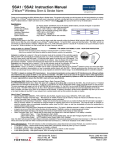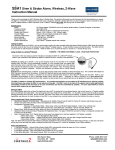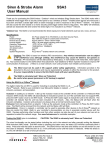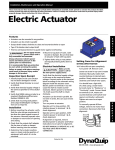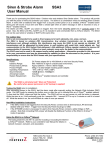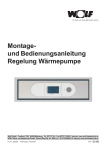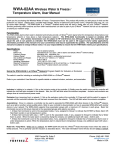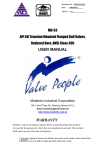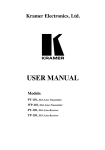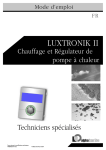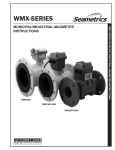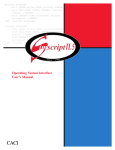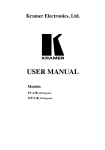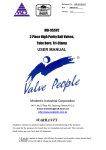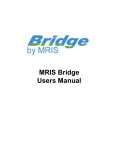Download Dyna Quip ZWACT1 Z-Wave Installation Manual
Transcript
WaterCop Z-Wave Emergency Water Shutoff Owner’s Manual and Installation Guide DynaQuip Controls • 10 Harris Industrial Park • St. Clair, MO 63077 Tel. 800-545-3636 • Fax. 636-629-5528 • www.watercop.com 1 Made in the USA Products that speak Z-Wave work together better. TM Contents Introduction . . . . . . . . . . . . . . . . . . . . . . . . . . 2 System Components . . . . . . . . . . . . . . . . . . . . .2 Product Specifications . . . . . . . . . . . . . . . . . . . 2 Pre-Installation Testing of WaterCop Z-Wave . . . . 3 OPERATION Front Panel Operation . . . . . . . . . . . . . . . . . . . .4 Mode Indications . . . . . . . . . . . . . . . . . . . . . . .5 Automatic Network Wide Inclusion . . . . . . . . . . .5 Manual Inclusion in a Z-Wave Network . . . . . . . .5 Exclusion from a Z-Wave Network . . . . . . . . . . . 6 Association with Water Sensors . . . . . . . . . . . . .6 Water Alarm Mode . . . . . . . . . . . . . . . . . . . . . 6 Manual Operation . . . . . . . . . . . . . . . . . . . . . . 6 Troubleshooting . . . . . . . . . . . . . . . . . . . . . . . .6 COMPLIANCE USA . . . . . . . . . . . . . . . . . . . . . . . . . . . . . . 6-7 Canada . . . . . . . . . . . . . . . . . . . . . . . . . . . . . 7 Europe . . . . . . . . . . . . . . . . . . . . . . . . . . . . . .8 How the System Works . . . . . . . . . . . . . . . . . . .8 Installation . . . . . . . . . . . . . . . . . . . . . . . . .8-10 Placement of Water Alarm Sensors . . . . . . . . . . 10 Operating the WaterCop Z-Wave . . . . . . . . . . 10-11 General Safety Information . . . . . . . . . . . . . . . 11 Emergency Procedures . . . . . . . . . . . . . . . . . . 11 Limited Warranty . . . . . . . . . . . . . . . . . . . . . . 12 Introduction WaterCop Z-Wave is a patented, wireless, water detection and automatic water shutoff system that works as an automatic valve for a home’s main water supply line and can be easily installed by a certified professional plumber. When used in a Z-Wave home automation network along with Z-Wave water alarm sensors (ZWCFS1), the WaterCop Z-Wave valve helps to effectively reduce water damage caused by leaky pipes or faulty appliances. WaterCop Z-Wave operates in a Z-Wave enabled home network which uses the latest and most successful wireless home automation technology to provide protection 24/7, 365 days a year. System Components The Emergency Water Shut-off Valve system has two basic components: 1. A motorized ball valve and housing containing a wireless Z-Wave radio transceiver which automatically turns off your water supply when any wireless water alarm sensor detects water or low, potentially freezing temperature. 2. A number of wireless water alarm sensors ZWCFS1, which detect water from a leak or overflow, or detect potentially freezing temperatures, and cause a wireless Z-Wave signal to be sent to the ZWCP to turn off the water supply. Product Specifications WaterCop Z-Wave uses a motorized ball valve (available in multiple sizes 1/2”, 3/4”, 1” and 1-1/4”), that is used to automatically turn off the main water supply when unwanted water is detected due to a leak or overflow. Multiple WaterCop Z-Wave valves can be used and/or programmed into a Z-Wave Home Automation System. Brass valve with commercial grade seats and seals. • Ball valve: full port brass forged body; NSF61 and NSF61-G (Lead Free) available • Seats: RTFE • Seals: Viton General Usage Specifications: • Maximum Working Pressure: 125 PSIG • Ambient Temperature: 35° to 105°F • For Cold Water Applications DynaQuip Controls • 10 Harris Industrial Park • St. Clair, MO 63077 Tel. 800-545-3636 • Fax. 636-629-5528 • www.watercop.com 2 Made in the USA Products that speak Z-Wave work together better. TM Enclosure: Polycarbonate, NEMA 4x (weather resistant) Voltage: 110V AC converted to 12V DC (Class 2 power converter with 20’ cord), 1.3A full load. Meets the approvals of state and municipal authorities. Three indicator lights. If the red light is on, it means that the valve is closed. The green light means that the valve is open, allowing water to flow freely through the plumbing system. If the yellow light is on or flashing, it means an error or the valve is not programmed into a Z-Wave network. Three panel-mount tactile switches to manually activate/program the valve. When installed properly in a Z-Wave network, the WaterCop Z-Wave and its system of ZWCFS1 sensors constantly monitor the home for a water leakage. The sensors are battery operated wireless water sensors strategically placed throughout the home. If one of these sensors trip, a wireless Z-Wave radio signal is relayed through the Z-Wave home network causing the WaterCop Z-Wave to turn off the household water supply. General Safety Information Adherence to all local and municipal building, plumbing and electrical codes as they pertain to the installation of the Water Valve ZWCP System is of utmost importance. Codes in some areas may require that a licensed plumber be employed to do the installation, or that the proper permits be obtained prior to installation. Even if local codes do not require a licensed plumber to do the installation, it is necessary that the installer has a professional level of competence in both plumbing and electrical skills to perform the installation. These instructions assume this level of knowledge and skill. If in doubt, use a licensed professional. Disconnect power source before working on or servicing the unit. Failure to do so could result in serious personal injury. It is strongly recommended that eye protection be worn while servicing the system. Failure to do so could result in personal injury. Pre-Installation Testing of WaterCop Z-Wave Although each unit is pre-tested at the factory, it is recommended that the unit be tested prior to installation to ensure proper operation in your home. Operating the valve before connecting the water line will not damage it. Use caution! • The valve closes with enough force to cut off a finger. • Be extremely careful to keep fingers and other items out of the valve. Manually Test the Valve • Check the position of the valve by looking in either threaded end. • In the open position, you will be able to see through the valve; in the closed position only the shiny surface of the ball will be visible. Place the base of the housing on a sturdy surface, as close as feasibly possible to the location where it will be permanently installed. Plug the WaterCop Z-Wave power adapter cord into a nearby 110V AC outlet. Within 10 seconds, the status indicator light will start blinking. Grasp both sides of the housing (not the valve) with the valve pointing away from you. Being very careful not to have your fingers or other objects near the valve openings, press the colored circle just below the unlit indicator light of the opposite valve position. You will hear the motor change the valve position. Again, look into the threaded end of the valve to verify that the valve has changed position. If it appears that the valve has not turned from one position to the other, DO NOT try to reposition the valve yourself by inserting any tool or fingers into the valve. Operate the valve several more times from open to close, checking each time for proper positioning. If you are experiencing difficulties getting the valve to open and close, call the installation help line listed on the back cover. DynaQuip Controls • 10 Harris Industrial Park • St. Clair, MO 63077 Tel. 800-545-3636 • Fax. 636-629-5528 • www.watercop.com 3 Made in the USA Products that speak Z-Wave work together better. TM Operation 1. Front Panel Operation a) Open and Close Buttons and their Indicator Lights • The Open and Close Buttons allow the user to control the valve locally. • The LED Indicator Lights will indicate the status of the valve, either open or closed. b) Program Button • The Program Button provides the means to include (add) the WaterCop Z-Wave into a Z-Wave network, exclude (remove) the valve from a Z-Wave network, and to switch between modes. • The operation of the Program Button for these different functions is described on page 5. c) Status Light • The Status Light gives an indication about the current mode or any error conditions. Generally, if the valve is in a Z-Wave network, the Status Light is turned off. The Status Light displays the indications in a cyclic manner, so zero, one, or more of the mode or error indications may be displayed sequentially and repeatedly. The mode indications are fast blinks, while the indications for error conditions are slow blinks. The mode indications are described on page 5, the error conditions can be found under section “Fault Conditions/Troubleshooting” on page 6. d) Power-On • At Power-On, the valve system should start blinking within 10 seconds (if not in a network) and needs to be set up with the actual position of the ball valve. To set up valve follow the sequence below: i. Press the Open Button ii. Press the Close Button iii. If “closed” is not the desired position, press the Open Button again Program Button Status Light Open Button/ Indicator Light Close Button/ Indicator Light AUTION: If the ball valve is not yet installed, KEEP FINGERS AND FOREIGN OBJECTS AWAY FROM THE C BALL VALVE WHILE OPERATING IT (either by using the buttons or using wireless, Z-Wave commands). Objects in the path of the closing valve can damage the ball valve and can cause serious injury. NOTE: The Water Valve could perform the first two steps of the set up (shown above) automatically at power-on, but, it was programmed not to do so, to avoid personal injury or damage to the valve due to foreign objects in its path. DynaQuip Controls • 10 Harris Industrial Park • St. Clair, MO 63077 Tel. 800-545-3636 • Fax. 636-629-5528 • www.watercop.com 4 Made in the USA Products that speak Z-Wave work together better. TM Operation (continued) 2. Mode Indications WaterCop Z-Wave Mode Number of Fast Blinks Comments Automatic Network Wide Inclusion (NWI) mode (Not available on some versions) 1 NWI mode is the default at initial power-on and is active for approx. 30 min. or until manually exited In-Network (The valve is in a Z-Wave network0 2 Not repeated, only given at power-on or after inclusion Out-of-Network (The valve is not in a Z-Wave network) 4 Default mode at initial power-on NOTE: Three (3) quick blinks indicate a function not applicable with this product. 3. Automatic Network Wide Inclusion (NWI) mode At power-on, in some versions and before the WaterCop Z-Wave is included in a network, the NWI mode is active. This mode allows automatic inclusion into an existing home network that has a Z-Wave controller supporting NWI mode. Please refer to your controller’s user manual to determine whether or not the NWI mode is supported. NWI mode is stopped after one of the following conditions occur: • The Water Valve is automatically included, • 30-minute timeout, or • The Program Button is pressed By pressing the Program Button, the user can perform a manual inclusion into the network (see below). WI mode is entered every time power is applied to the Water Valve, if it is not already a part of a N Z-Wave network (included). 4. Inclusion (Manual) in a Z-Wave Network To manually add (include) the WaterCop Z-Wave to a Z-Wave network, you must also have a Z-Wave Controller. Follow your Z-Wave Controller User Manual to configure the Controller for Inclusion Mode. Once the Controller is in Inclusion Mode, ensure that the Status Light is flashing periodically (3 or 4 times). ress the Program Button once. The Controller will indicate when the WaterCop Z-Wave is included and the P Status Light will stop flashing. NOTE: Inclusion and Exclusion are always done at Normal Transit Power Mode. 5. Exclusion from a Z-Wave Network To manually remove (exclude) the WaterCop Z-Wave from a Z-Wave network, follow your Z-Wave Controller User Manual to configure the controller for Exclusion Mode. nce the Controller is in Exclusion Mode, press the Program Button once. The Controller will indicate when O the WaterCop Z-Wave is excluded and the Status Light will start flashing periodically (3 or 4 times). NOTE: Inclusion and Exclusion are always done at Normal Transit Power Mode. DynaQuip Controls • 10 Harris Industrial Park • St. Clair, MO 63077 Tel. 800-545-3636 • Fax. 636-629-5528 • www.watercop.com 5 Made in the USA Products that speak Z-Wave work together better. TM Operation (continued) 6. Association with One or More Water Sensors Once in a network, a smart Controller can be used to associate water sensors with the WaterCop Z-Wave. Association allows a sensor to control a WaterCop Z-Wave directly without going through a Controller. Refer to your Controller’s documentation on how to associate devices. Typically, when associated, the WaterCop Z-Wave receives a Basic Set command to close the ball valve (when a Water Alarm is active). If a water sensor is not associated with the WaterCop Z-Wave, then a Controller receives the message from the water sensors and, in turn, sends a Binary Switch command to the WaterCop Z-Wave to close the attached ball valve. 7. Water Alarm Mode This mode is the default mode from the factory and provides protection in case of water leaks. The WaterCop Z-Wave will close when receiving a Basic Set Command from an associated sensor. You must manually open the WaterCop Z-Wave after fixing the leak or checking to ensure that the leak has actually stopped since water may have merely run away from the sensor. In this situation, the WaterCop Z-Wave can be manually opened by either using the Open Button or sending a Binary Switch Set command to the WaterCop Z-Wave. 8. Manual Operation (no AC power available) WaterCop Z-Wave will not operate when power is not present at the AC/DC power converter (for example, during blackouts). In this situation, the handle at the top of the WaterCop Z-Wave can be turned in the direction indicated to turn off the water in an emergency. 9. Fault Conditions/Troubleshooting The Status LED provides the following fault indications represented by 2 or more slow, periodic blinks. Generally, these should never occur. The presence of one of these status indications may mean that something is wrong with the Water Valve hardware. Fault Indication Number of Slow Blinks Comments Motor Jammed/Timeout Error 3 Ensure that nothing is blocking the ball valve; cycle power to the WaterCop Z-Wave Communication (I2C) Error 4 Cycle power to the WaterCop Z-Wave ADC Error 5 Cycle power to the WaterCop Z-Wave Time Error 6 Cycle power to the WaterCop Z-Wave State Error 7 Cycle power to the WaterCop Z-Wave Unknown Error 8 Cycle power to the WaterCop Z-Wave USA This device complies with Part 15 of the FCC Rules. Operation is subject to the following two conditions: 1. This device may not cause harmful interference, and 2. This device must accept any interference received, including those that may cause undesired operation. DynaQuip Controls • 10 Harris Industrial Park • St. Clair, MO 63077 Tel. 800-545-3636 • Fax. 636-629-5528 • www.watercop.com 6 Made in the USA Products that speak Z-Wave work together better. TM Contains Transmitter Module FCC ID: XCT-Z3US This equipment has been tested and found to comply with the limits for a Class B digital device, pursuant to Part 15 of the FCC Rules. These limits are designed to provide reasonable protection against harmful interference in a residential installation. This equipment generates, uses and can radiate radio frequency energy and, if not installed and used in accordance with the instructions, may cause harmful interference to radio communications. However, there is no guarantee that interference will not occur in a particular installation. If this equipment does cause harmful interference to radio or television reception, which can be determined by turning the equipment off and on, the user is encouraged to try to correct the interference by one or more of the following measures: • Reorient or relocate the receiving antenna • Increase the separation between equipment and receiver • Connect the equipment into an outlet on a circuit different from that to which the receiver is connected • Consult the dealer or an experienced radio/TV technician for help RF Exposure All transmitters regulated by FCC must comply with RF Exposure requirements. OET Bulletin 65 “Evaluating Compliance with FCC Guidelines for Human Exposure to Radio Frequency Electromagnetic Fields” provides assistance in determining whether proposed or existing transmitting facilities, operations or devices comply with limits for human exposure to Radio Frequency (RF) fields adopted by the Federal Communications Commission (FCC). The bulletin offers guidelines and suggestion for evaluating compliance. CAUTION To satisfy FCC RF Exposure requirements for mobile and base station transmission devises, a separation distance of 20cm or more should be maintained between the antenna of this device and persons during operation. To ensure compliance, operation at closer than this distance is not recommended. Canada Industry Canada Statement per Section 4.0 of RSP-100: The term “IC” before the certification/registration number only signifies that the Industry Canada technical specifications have been met. Section 7.1.5 of RSS-GEN Operation is subject to the following conditions: 1. This devise may not cause harmful interference, and 2. This device must accept any interference received, including those that may cause undesired operation. From Section 7.1.1 of RSS-GEN, Issue 2, June 2007 a) The host device, as a stand-alone unit without any separately certified modules, complies with all applicable Radio Standards Specifications. b) The host device and all separately certified modules it contains jointly meet the RF exposure compliance requirements of RSS-102, if applicable. c) The host device complies with the certification labeling requirements of each of the modules it contains. From Section 5.2 of RSS-GEN, Issue 2, June 2007 Equipment Labels: Contains IC: 8156A-Z3X From Section 7.1.6 of RSS-GEN, Issue 2, June 2007 Digital Circuits: If the device contains digital circuitry that is not directly associated with the radio transmitter, the device shall also comply with ICES-003 Class A or B as appropriate, except for ICEC-003 labeling requirements. The test data obtained (for the ICES-003 tests) shall be kept by the manufacturer or importer whose name appears on the equipment label, and made available to Industry Canada upon request, for as long as the model is being marketed in Canada. DynaQuip Controls • 10 Harris Industrial Park • St. Clair, MO 63077 Tel. 800-545-3636 • Fax. 636-629-5528 • www.watercop.com 7 Made in the USA Products that speak Z-Wave work together better. TM Europe1 T he WaterCop Z-Wave module has been certified for use in European countries. The following testing has been completed: Test Standard: ETSI EN 300 328 V1.7.1 (2006-10) NOTE: To be completed Q1: 2010. 1 How the System Works ater Sensors ZWCFS1 constantly monitor their selected areas for accumulating moisture. When a leak is detected, a W sensor will send a radio frequency signal to the WaterCop Z-Wave, instructing it to shut off the water supply to the home. The WaterCop Z-Wave will remain closed until it‘s manually reset. The Water Alarm Sensors ZWCFS1 are battery powered devices which enables them to be located anywhere a leak is likely to occur, or where water might cause damage. The WaterCop Z-Wave requires household electrical power 110V AC, and will not operate during a power outage. Power Supply Program Button Properly Sized Brass Valve Plumbed Into Water Line Emergency Manual Shut-off Local Push Button ‘Close’ Control Local Push Button ‘Open’ Control Installation Review Location and Type of Main Supply Line The main supply line should enter the house in either the basement or crawl space beneath the first floor. The water main shut-off valve is usually located near where the line comes through the basement wall or just after the water line enters the living area from the crawl space. In apartments, townhouses, and manufactured homes the water main shut-off valve can usually be found in close proximity to the water heater installation. The WaterCop Z-Wave should be installed in the main water line just downstream from the main shut-off valve in your home. DynaQuip Controls • 10 Harris Industrial Park • St. Clair, MO 63077 Tel. 800-545-3636 • Fax. 636-629-5528 • www.watercop.com 8 Made in the USA Products that speak Z-Wave work together better. TM The WaterCop Z-Wave must be installed indoors: • In the main water line; • Just downstream from the main water shut-off valve; • In a dry location; • Where it is accessible for checking and resetting the valve: • Where the case is protected from use as a step or from excessive loads. CAUTION: Local electrical and plumbing codes should be consulted to ensure that the installation is in complete compliance! CAUTION: Never use the housing for leverage when mounting this unit or tightening fittings. Use a wrench on the valve flats provided. CAUTION: High heat from soldering or brazing can damage valve seats or motor housing. Proper precautions should be taken to prevent damage from heat when installing the unit. Remove plastic housing before soldering valve in place. Additional Parts Requirements Installation of WaterCop Z-Wave will require additional parts. When the main supply line is cut to accommodate the WaterCop Z-Wave new fittings will be needed to connect the ends of the piping to the WaterCop Z-Wave. The type of connecting fittings to use will be determined by the type of existing piping, local plumbing codes, and “industry standard practices”. The most common material for water supply lines is copper. If the WaterCop Z-Wave is to be installed in a copper line, you may have multiple choices of fittings and methods of installation. Compression Fittings The unit can be installed with compression fittings using common household tools and basic mechanical ability. You will need: a) 2 fittings (male pipe thread x compression) available at most local hardware or plumbing supply stores b) Teflon tape or thread sealant c) Tubing cutter d) Ruler e) Pencil or marker f) 2 large adjustable wrenches Measure the outside diameter of the copper tube and note the valve size to be sure the proper size fittings are purchased. Steps of Installation Using Compression Fittings: 1. Remove nuts and sleeves from compression fittings and install fittings into each end of the valve using Teflon tape or thread sealant to ensure a watertight seal. Hold wrench on flats of valve body and use the other to tighten fittings. 2. Measure the distance from end to end of valve assembly. For 1/2” tube (5/8” outside diameter) subtract 1/2”, for 3/4” tube (7/8” outside diameter) subtract 3/4” from your measurement. This is the length of the section of tubing to be cut out of the existing line. The piece of existing tubing to be cut out is shorter than the measured length of the valve assembly so that the tube extends into the compression fittings. 3. Select the location for the WaterCop Z-Wave. Be sure to consider that you will need access to the front panel of the WaterCop Z-Wave and that a power outlet is in close proximity. After cutting the section of tube out of the line, you will need to shift the tube ends to be able to fit the unit in place. Make sure you have access and room to adjust before cutting the tube. DynaQuip Controls • 10 Harris Industrial Park • St. Clair, MO 63077 Tel. 800-545-3636 • Fax. 636-629-5528 • www.watercop.com 9 Made in the USA Products that speak Z-Wave work together better. TM 4. Mark the tube in the location you have selected. Double check the length and location you marked. 5. Turn water off and drain the system. 6. Use tube cutter to cut copper tube at the marks. Careful, water may still be in the line. 7. Remove any burrs from tube ends and clean ends. 8. Install compression nuts and sleeves to each tube end. 9. Shift tube ends to install WaterCop Z-Wave in the line. 10. Position the unit and tighten compression nuts. Hold the fitting with one wrench while tightening the nut with the other. Tighten both nuts. 11. Plug unit into a proper power source and turn valve to open position (open button/green light). 12. Unplug unit, turn water back on and carefully check for leaks. 13. Plug unit back into power source. Installation is complete. Solder Fittings An alternative method is to solder the unit into the water line. This method requires a considerably higher skill level to accomplish the installation properly and safely. If you are not skilled in this area, it is strongly recommended that you contact a professional plumber to do this type of installation. Placement of Water Alarm Sensors ZWCFS1 Each WaterCop Z-Wave can support multiple Water Alarm Sensors. A WaterCop Z-Wave network can have up to 232 nodes. Additional sensors may be added at any time. The Water Alarm Sensors should be placed in locations where leaks are most likely to occur. Suggested Locations: Washing Machines • Toilets • Sump Pumps • Dishwashers • Bathroom Sinks • Kitchen Sinks • Automatic Humidifiers • Ice Makers/Refrigerators • Water Heaters • Pipes that are prone to freezing (ZWCFS1 also works as a Freeze Alarm Sensor) Operating the WaterCop Z-Wave NOTE: If major repairs are needed to correct the plumbing system, it is recommended that the manual shut-off valve upstream of the WaterCop Z-Wave also be closed during the repairs. Close the main water shut-off valve and unplug the WaterCop Z-Wave before making repairs on the plumbing system. In case of a power failure and without a backup battery, the WaterCop Z-Wave cannot operate. If the power is out, you will need to use the manual shut-off valve to turn the water off in case of an emergency. When power is restored, the WaterCop Z-Wave must be cycled via the Open/Close Buttons or Z-Wave Binary Switch Command to ensure that the current ball valve position is known. It is recommended to manually cycle (open-close-open) your WaterCop Z-Wave once every 3-4 months. Test Procedure After the WaterCop Z-Wave has been installed and included in a network, and the controller/water sensor(s) have been included and configured, perform the following steps to test the WaterCop Z-Wave system: DynaQuip Controls • 10 Harris Industrial Park • St. Clair, MO 63077 Tel. 800-545-3636 • Fax. 636-629-5528 • www.watercop.com 10 Made in the USA Products that speak Z-Wave work together better. TM 1. Following all safety precautions, make sure that the WaterCop Z-Wave is plugged in and the valve is in the open position. If the WaterCop Z-Wave is not installed, it is important that anyone who will be near the valve is aware of the safety precautions, and does not insert any object into the valve, or handle the valve during the test. 2. At one of the locations you have chosen to monitor, wet the two metal contacts on the back of the ZWCFS1 sensor enclosure (just under the label) with a damp paper towel or cloth. Hold until the sensor transmits a signal to the WaterCop Z-Wave (approx. 5 seconds). This test simulates a leak, and lets you check for interference between the sensor and the WaterCop Z-Wave. 3. Carefully dry off the sensor. The sensor should stop beeping. 4. Go back to your WaterCop Z-Wave and verify that the valve is closed (the red indicator light will be lit). 5. Keeping all objects away from the valve; reset the WaterCop Z-Wave by pressing the green circle next to “Open” text. 6. Repeat steps 2 through 5 until you have tested each sensor at the locations you wish to monitor. General Safety Information Warnings and Precautions Warning The motorized drive unit case is not capable of supporting loads. Do not attempt to use the unit as a step. This will cause damage to the unit and could cause personal injury. Do not store highly flammable items such as oily rags or other combustibles near theWaterCop Z-Wave. Warning Do not apply electrical power to the unit unless the unit is fully assembled (as it was shipped). Failure to do so could result in personal injury and/or damage to the unit. Warning Disconnect power source before working on or servicing the unit. Failure to do so could result in personal injury. Caution It is recommended that eye protection be worn while installing or servicing the system. Failure to do so could result in personal injury. Caution Do not use the case as leverage when mounting this unit or tightening fittings. Apply wrench to flats on the valve body to tighten fittings. Emergency Procedures In the unlikely event that the WaterCop Z-Wave System should shut off the main water supply and then become inoperable due to power outage or damage, it is possible to manually operate it to return water service. Unplug the WaterCop Z-Wave from its power source. The valve may be manually turned with the handle at the side. This procedure should only be necessary in emergencies. Similarly, the handle can be used to turn off the water supply in an emergency. DynaQuip Controls • 10 Harris Industrial Park • St. Clair, MO 63077 Tel. 800-545-3636 • Fax. 636-629-5528 • www.watercop.com 11 Made in the USA Products that speak Z-Wave work together better. TM Limited Warranty This product is provided with a two-year limited manufacturer warranty. Limited Warranty DynaQuip Controls Corporation, 10 Harris Industrial Park, Saint Clair, Missouri 63077, warrants its WaterCop electric valve actuator and electronic sensor and electronic system control components against defects in material and workmanship for a period of two (2) years from the date of original shipment. DynaQuip Controls warrants its WaterCop brass ball valve mechanical component against defects in material and workmanship for the life of the component. In the event that such defects appear within the warranty period, DynaQuip Controls will, at its option, and upon written notification thereof and substantiation that, the product(s) have been stored, installed, maintained and operated in accordance with DynaQuip’s recommendations and standard industry practice, repair or replace the product without charge. This warranty shall be invalidated by any abuse, misuse, misapplication, improper installation, modification, or disassembly at any place other than the point of original manufacture. This shall constitute the exclusive remedy for breach of warranty, and DynaQuip Controls shall not be responsible for any incidental or consequential damages, including, without limitation, damages or other costs resulting from labor charges, delays, vandalism, negligence, fouling caused by foreign material, damage from adverse water conditions, chemicals, weather, or any other circumstances over which DynaQuip Controls has no control. DYNAQUIP CONTROLS MAKES NO OTHER WARRANTIES EXPRESS OR IMPLIED EXCEPT AS PROVIDED BY THIS LIMITED WARRANTY. The seller does not represent that the product; will prevent any property loss by sudden or accidental discharge of water from plumbing systems into living area of a residential dwelling; may not be compromised or circumvented; or that the product will in all cases provide adequate warning or protection. Buyer understands that a properly installed and maintained automatic water shut-off system may only reduce the risk of a sudden and accidental water loss event resulting in significant water damage and is not insurance or a guarantee that such will not occur or that there will be no personal injury or property loss as a result. CONSEQUENTLY, SELLER SHALL HAVE NO LIABILITY FOR ANY PERSONAL INJURY, PROPERTY DAMAGE OR OTHER LOSS BASED ON A CLAIM THE PRODUCT FAILED TO TURN OFF WATER SUPPLY OR GIVE WARNING OF A POTENTIAL WATER LOSS EVENT. HOWEVER, IF SELLER IS HELD LIABLE, WHETHER DIRECTLY OR INDIRECTLY, FOR ANY LOSS OR DAMAGE ARISING UNDER THIS LIMITED WARRANTY OR OTHERWISE, REGARDLESS OF CAUSE OR ORIGIN, SELLER’S MAXIMUM LIABILITY SHALL NOT IN ANY CASE EXCEED THE ORIGINAL PURCHASE PRICE OF THE PRODUCT, WHICH SHALL BE THE COMPLETE AND EXCLUSIVE REMEDY AGAINST THE SELLER. This warranty gives you specific legal rights, and you may also have other rights which may vary from state to state. No increase or alteration, written or verbal, to this warranty is authorized. DynaQuip Controls Corporation reserves the right to change or improve the design of any DynaQuip Controls manufactured product without assuming any obligations to modify product previously manufactured or sold. All products returned to Dynaquip Controls Inc. must have a valid Returned Goods Authorization (RGA). For additional warranty information, please contact us: Dynaquip Controls Inc. 10 Harris Industrial Park St. Clair, MO 63077 T he WaterCop Z-Wave controller and sensor system is based on wireless (RF) transmissions through the air. Any wireless transmission can be subject to RF interference and, although it is highly unlikely, this interference may cause the WaterCop Z-Wave system to not operate as intended. The WaterCop Z-Wave system must not be used in life support and/or safety applications. Information contained in this publication regarding WaterCop Z-Wave applications and the like is provided only for your convenience and may be superseded by updates. It is your responsibility to ensure that the WaterCop Z-Wave application meets with your specifications. DynaQuip Controls • 10 Harris Industrial Park • St. Clair, MO 63077 Tel. 800-545-3636 • Fax. 636-629-5528 • www.watercop.com 12 Made in the USA Products that speak Z-Wave work together better. TM PN 192340












